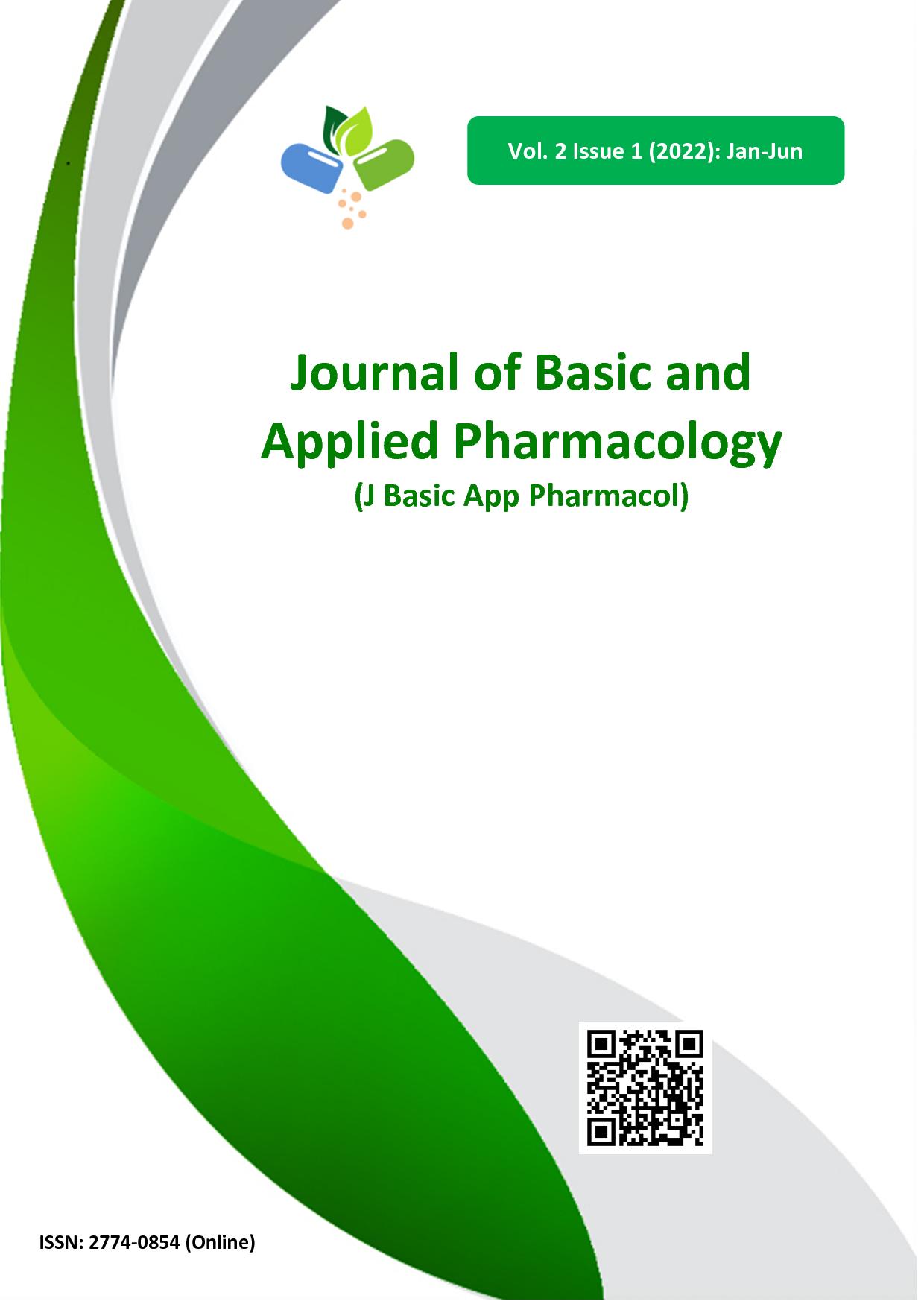The Hypoglycemic Potential of Endophytic Lactobacillus kunkeei, Isolated from Dandelion Flowers in Rats
Main Article Content
Abstract
Blood glucose level control is a widely used approach, as diabetes mellitus is increasing worldwide. Lactobacillales have recently attracted the greatest attention due to their diabetes alleviating effects. Therefore, the current study was designed with the objective to evaluate the antidiabetic potential of entophytic Lactobacillus kunkei isolated from local Taraxacum kok-saghyz L. in glucose-, adrenaline-, and alloxan-induced diabetic rat models. In this study, the L.kunkeei strain was isolated from local Taraxacum kok-saghyz L. (locality Tashkent, Uzbekistan). Blood glucose in glucose-, adrenaline-, alloxan-induced and MDA level in alloxan-induced diabetic rats under L. kunkeei pretreatment was evaluated. In the current study, blood glucose levels were significantly improved by L. kunkeei in glucose-, adrenaline- and alloxan-induced diabetic rats in vivo. In addition, the strain exhibited in vitro α-amylase inhibiting effects, as well as reduced oxidative stress in the liver and the pancreas of alloxan-induced diabetic rats. Based on these studies, it is believed that food supplements of specific lactic acid bacteria strains can be effective as a preventive strategy against metabolic disorders. However, further long-term studies are needed to validate the specific constituents and, thus, the mechanisms responsible for the hypoglycemia-reducing effect of L. kunkeei.
Article Details

This work is licensed under a Creative Commons Attribution-NonCommercial-NoDerivatives 4.0 International License.
Upon acceptance of an article, the Pharmacological and Therapeutic Society of Thailand will have exclusive right to publish and distribute the article in all forms and media and grant rights to others. Authors have rights to use and share their own published articles.
References
Rodríguez-Gutiérrez R, Montori VM. Glycemic control for patients with type 2 diabetes mellitus: our evolving faith in the face of evidence. Circ Cardiovasc Qual Outcomes. 2016;9(5):504-512.
Oboh G, Isaac AT, Akinyemi AJ, Ajani RA. Inhibition of key enzymes linked to type 2 diabetes and sodium nitroprusside induced lipid peroxidation in rats' pancreas by phenolic extracts of avocado pear leaves and fruit. Int J Biomed Sci. 2014;10(3):208-216.
Asmat U, Abad K, Ismail K. Diabetes mellitus and oxidative stress - A concise review. Saudi Pharm J. 2016;24(5):547-553.
Tripathi KD. Ed. Essentials of Medical Pharmacology, 5th ed, Jaypee Brothers, Medical Publishers (P) Ltd, New Delhi. 2004;33:103-118.
Wirngo FE, Lambert MN, Jeppesen PB. The physiological effects of Dandelion (Taraxacum officinale) in type 2 diabetes. Rev Diabet Stud. 2016;13(2-3):113-131.
Amirsaidova DI, Bekmurodova G, Miralimova SM, Imamaliev BA. The hypoglycemic activity of lactic acid bacteria isolated from medicinal plants of Uzbekistan and their probiotic potential. J Pharm Res Int. 2021;33(60B), 445-457.
Honda K, Moto M, Uchida N, He F, Hashizume N. Anti-diabetic effects of lactic acid bacteria in normal and type 2 diabetic mice. J Clin Biochem Nutr. 2012;51(2):96-101.
Heath RL, Packer L. Photoperoxidation in isolated chloroplasts. I. Kinetics and stoichiometry of fatty acid peroxidation. Arch. Biochem. Biophys. 1968;125(1):189-198.
Ugolev AM. Opredelenie amiloliticheskoj aktivnosti. Issledovanie pishhevaritel'nogo apparata u cheloveka - L.: Nauka. 1969.
Official Journal of the European Union. European Directive 2010/63/EU on the protection of animals used for scientific purposes. September 22, – 2010. Available from: https://eur-lex.europa.eu/LexUriServ/LexUriServ.do?uri=OJ:L:2010:276:0033:0079:en:PDF
Hartree EF. Determination of protein: A modification of the lowry method that gives a linear photometric response. Anal Biochem. 1972;48(2):422-427.
Litchfield JT, Wilcoxon F. A simplified method of evaluating dose-effect experiments. J Pharmacol Exp Ther. 1949;96(2):99-113.
Bürger C, Fischer DR, Cordenunzzi DA, Batschauer AP, Cechinel Filho V, Soares AR. Acute and subacute toxicity of the hydroalcoholic extract from Wedelia paludosa (Acmela brasiliensis) (Asteraceae) in mice. Int J Pharm Pharm Sci. 2005;8(2):370-373.
Sheikh Hosseini S, Gol A, Khaleghi M. The effects of the Lactobacillus acidophilus ATCC 4356 on the oxidative stress of reproductive system in diabetic male rats. Int J Reprod Biomed. 2019;17(7):493-502.
Yin P, Wang Y, Yang L, Sui J, Liu Y. Hypoglycemic effects in alloxan-induced diabetic rats of the phenolic extract from Mongolian oak cups enriched in ellagic acid, kaempferol and their derivatives. Molecules. 2018;23(5):1046.
Verberne AJM, Korim WS, Sabetghadam A, Llewellyn-Smith IJ. Adrenaline: insights into its metabolic roles in hypoglycaemia and diabetes. Br J Pharmacol. 2016;173(9):1425-1437.
Gurung M, Li Z, You H, Rodrigues R, Jump DB, Morgun A, et al. Role of gut microbiota in type 2 diabetes pathophysiology. EBioMedicine. 2020;51:102590.
Hemarajata P, Versalovic J. Effects of probiotics on gut microbiota: mechanisms of intestinal immunomodulation and neuromodulation. Therap Adv Gastroenterol. 2013;6(1):39–51.
Obaroakpo U, Liu L, Zhang S, Lu J, Zhang C, Pang X, et al. Potent α-amylase inhibitory activity of sprouted quinoa-based yoghurt beverages fermented with selected anti-diabetic strains of lactic acid bacteria. RSC Advances. 2019;9:9486-9493.
Won G, Choi SI, Park N, Kim JE, Kang CH, Kim GH. In vitro antidiabetic, antioxidant activity, and probiotic activities of Lactiplantibacillus plantarum and Lacticaseibacillus paracasei strains. Curr. Microbiol. 2021;78(8):3181-3191.
Wang Y, Wu J, Lv M, Shao Z, Hungwe M, Wang J, et al. Metabolism characteristics of lactic acid bacteria and the expanding applications in food industry. Front Bioeng Biotechnol. 2021;9:612285.
Giacco F, Brownlee M. Oxidative stress and diabetic complications. Circ Res. 2010;107(9):1058-1070.
Abubakr M, Hassan Z, Imdakim M, Sharifah NR. Antioxidant activity of lactic acid bacteria (LAB) fermented skim milk as determined by 1,1-diphenyl-2-picrylhydrazyl (DPPH) and ferrous chelating activity (FCA). Afr J Microbiol Res. 2012;6:6358-6364.
Kuo HC, Kwong HK, Chen HY, Hsu HY, Yu SH, Hsieh CW, et al. Enhanced antioxidant activity of Chenopodium formosanum Koidz. by lactic acid bacteria: optimization of fermentation conditions. PloS One. 2021; 16(5):e0249250.
Mazloom Z, Yousefinejad A, Dabbaghmanesh MH. Effect of probiotics on lipid profile, glycemic control, insulin action, oxidative stress, and inflammatory markers in patients with type 2 diabetes: a clinical trial. Iran J Med Sci. 2013:38(1): 38-43.


